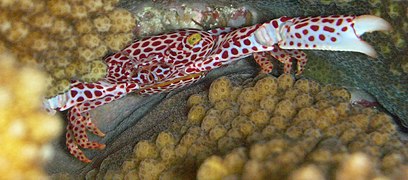| Pocillopora | |
|---|---|

| |
| Pocillopora meandrina with a resident fish | |
| Scientific classification | |
| Domain: | Eukaryota |
| Kingdom: | Animalia |
| Phylum: | Cnidaria |
| Class: | Hexacorallia |
| Order: | Scleractinia |
| Family: | Pocilloporidae |
| Genus: | Pocillopora Lamarck, 1816 |
| Species | |
| See text | |
Pocillopora is a genus of stony corals in the family Pocilloporidae occurring in the Pacific and Indian Oceans. They are commonly called cauliflower corals and brush corals.
Description
Cauliflower corals are widespread and can be identified by the presence of wart-like growths on their surface. The colonies can be dome shaped or branching and are very variable in colour and shape depending on the species and the environmental conditions. Species situated on shallow reefs pounded by the sea tend to be stunted whilst those in deep calm water are often thin and open. Each individual polyp has tentacles but these are normally extended only at night.
Biology
The polyps are hermaphrodite, possessing four sets of male and four sets of female gonads. Pocillopora can reproduce asexually via fragmentation. They also reproduce sexually and the larvae develop inside the polyps rather than free floating in the water, a reproduction strategy known as brooding. When they are mature, the larvae are released and can remain free-swimming for several weeks before settling on the substrate.
Pocillopora corals contain microscopic symbiotic algae (zooxanthellae) living within them. Through photosynthesis, these algae produce energy-rich molecules that the coral polyps can assimilate. In return, the coral provides the algae with protection and access to sunlight. The polyps also feed by capturing tiny particles using their tentacles. These corals are widespread because they sometimes attach to floating objects and can be carried far afield by currents and wind.
Species
The World Register of Marine Species includes the following species in the genus:
- Pocillopora acuta Lamarck, 1816
- Pocillopora aliciae Schmidt-Roach, Miller & Andreakis, 2013
- Pocillopora ankeli Scheer & Pillai, 1974
- Pocillopora bairdi Schmidt-Roach, 2014
- Pocillopora brevicornis Lamarck, 1816
- Pocillopora capitata Verrill, 1864
- Pocillopora damicornis (Linnaeus, 1758)
- Pocillopora effusus Veron, 2002
- Pocillopora elegans Dana, 1846
- Pocillopora fungiformis Veron, 2002
- Pocillopora grandis Milne Edwards & Haime, 1860
- Pocillopora indiania Veron, 2002
- Pocillopora inflata Glynn, 1999
- Pocillopora kelleheri Veron, 2002
- Pocillopora ligulata Dana, 1846
- Pocillopora mauritiana Brüggemann, 1877
- Pocillopora meandrina Dana, 1846
- Pocillopora molokensis Vaughan, 1907
- Pocillopora verrucosa (Ellis and Solander, 1786)
- †Pocillopora vitiensis Hoffmeister, 1945
- Pocillopora woodjonesi Vaughan, 1918
- Pocillopora zelli Veron, 2002
-
 Pocillopora damicornis
Pocillopora damicornis
-
 Pocillopora elegans
Pocillopora elegans
-
 Pocillopora grandis
Pocillopora grandis
-
 Pocillopora meandrina
Pocillopora meandrina
-
 Pocillopora verrucosa
Pocillopora verrucosa
- Non exhaustive gallery of symbionts
-
Trapezia flavopunctata
-
Trapezia rufopunctata
-
 Trapezia tigrina
Trapezia tigrina
-
 Scab due to a female of Cryptochiridae (probably Hapalocarcinus marsupialis)
Scab due to a female of Cryptochiridae (probably Hapalocarcinus marsupialis)
-
Alpheus lottini
-
Thor amboinensis
-
Sebastapistes tinkhami
-
Paragobiodon modestus
-
Paracirrhites forsteri
References
- ^ Veron, J.E.N. (2000) Corals of the World. Australian Institute of Marine Science, Townville, Australia.
- Veron, J.E.N. (1986) Corals of Australia and the Indo-Pacific. Angus & Robertson Publishers, London, UK.
- Green, E. and Shirley, F. (1999) The Global Trade in Corals. World Conservation Press, Cambridge, UK.
- "ARKive". Archived from the original on 2011-03-13. Retrieved 2011-04-03.
- "WoRMS - World Register of Marine Species - Pocillopora Lamarck, 1816". www.marinespecies.org. Retrieved 2018-08-17.
- Schmidt-Roach S, Miller KJ, Andreakis N (2013) Pocillopora aliciae: a new species of scleractinian coral (Scleractinia, Pocilloporidae) from subtropical Eastern Australia. Zootaxa 3626: 576–582.
- Schmidt-Roach S, Miller KJ, Lundgren P, Andreakis N (2014) With eyes wide open: a revision of species within and closely related to the Pocillopora damicornis species complex (Scleractinia; Pocilloporidae) using morphology and genetics. Zoological Journal of the Linnean Society 170: 1-33.